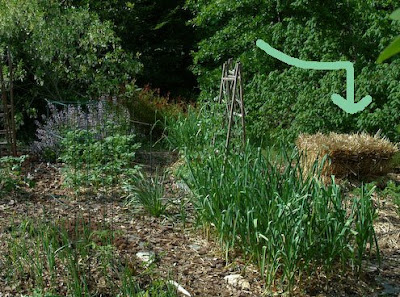Straw bale gardening
I'm venturing into experimenting with vegetables in straw bales partially because I can pretend that I'm not expanding my garden (ha!)
I now have 5 bales for planting, one older bale that was pulled from compost pile protection duty (now planted with trailing squashes) , 2 older bales that were starting compost pile duty (and I struggled to tip over end to end to their new site), and 2 fresh bales that hopefully have aged enough to support plants. The latter are yet to be planted.
 I justified this by buying 4 new straw bales to take on compost protection duty (from our gardening assistant, aka Mocha our Golden Retriever, who loves compost scavenging, which gives him indigestion.)
I justified this by buying 4 new straw bales to take on compost protection duty (from our gardening assistant, aka Mocha our Golden Retriever, who loves compost scavenging, which gives him indigestion.)
The premise behind straw bales is excellent -- start the straw decomposing, whether with ammonium nitrate or compost tea or rain water. Dig out a spot to put in potting soil or compost, plant, and proceed to keep the bale moist and nutrient-rich, with added nutrients, compost tea, slow-release fertilizers, or even inoculations of mycorrhizal fungi.
And, then plant, either in an excavated hole filled with compost or potting mix, or simply poking a transplant between the straw. I'm opting for the former, even though straw bales are really just a form of hydroponic gardening.
I now have 5 bales for planting, one older bale that was pulled from compost pile protection duty (now planted with trailing squashes) , 2 older bales that were starting compost pile duty (and I struggled to tip over end to end to their new site), and 2 fresh bales that hopefully have aged enough to support plants. The latter are yet to be planted.
 I justified this by buying 4 new straw bales to take on compost protection duty (from our gardening assistant, aka Mocha our Golden Retriever, who loves compost scavenging, which gives him indigestion.)
I justified this by buying 4 new straw bales to take on compost protection duty (from our gardening assistant, aka Mocha our Golden Retriever, who loves compost scavenging, which gives him indigestion.)The premise behind straw bales is excellent -- start the straw decomposing, whether with ammonium nitrate or compost tea or rain water. Dig out a spot to put in potting soil or compost, plant, and proceed to keep the bale moist and nutrient-rich, with added nutrients, compost tea, slow-release fertilizers, or even inoculations of mycorrhizal fungi.
And, then plant, either in an excavated hole filled with compost or potting mix, or simply poking a transplant between the straw. I'm opting for the former, even though straw bales are really just a form of hydroponic gardening.
I think I would opt for the soil addition to the bales...watering in the summer would have to be more often if you just planted into the bale.
ReplyDeleteEmail me your address and I will send you Penstemon X! gail
ReplyDeleteI forgot to comment on the straw bales! I've always thought I could use bales to create a raised bed...simple and cheap, but this is very creative! gail
ReplyDeleteWhat a great idea! I hadn't thought of using bales in this way: I had always used them for retaining.
ReplyDeleteWill try!
Rob